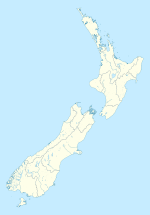Kakahi, New Zealand

Kakahi (correctly, Kākahi) is a small King Country settlement about 10 kilometres (6.2 mi) up the Whanganui River from Taumarunui, New Zealand. Founded as a sawmill town, it takes its name from the Māori word for the New Zealand freshwater mussel.
Geography
Kakahi can be reached from State Highway 4, and the North Island Main Trunk Railway passes through it across a bridge over the Kakahi Stream. The Whanganui River and Whakapapa River meet about five kilometres to the east, about 1 km from the end of the Te Rena Road (an old logging tram line). Te Rena Road is notable for extensive colonies of glowworms along the sheer banks where the road cuts deeply through the hillside.
History
Kakahi has a long history of Māori settlement, and four fortified pā sites.[1] In about the 15th century, Ngāti Hotu people were defeated here by Whanganui Māori in the battle of the five forts. A marae of the Ngāti Manunui hapū of Ngāti Tūwharetoa is located in the town; its whare tipuna, built in 1913, is called Taumaihiōrongo.[2]
1862, February: James Coutts Crawford crosses the Whakapapa River and camps across from Terena.[3]
20th century: Last century Kakahi was a King Country sawmill town, with four timber mills around the township, many tram lines for moving the timber (mainly totara). Kakahi also had three churches, one hotel (burned to the ground), one boarding house and a pool hall. It still has the active Kakahi Primary School (Photos), the Kakahi General Store (also a post office), and the Kakahi Hall (which has been restored to full function by the community).
1906: Ngāti Tūwharetoa and the Tongariro Timber Company struck an agreement for the construction of a 40-mile (64 km) Kakahi to Pukawa railway line, connecting the main trunk line to the shores of Lake Taupo. This was in exchange for the milling rights of 134,500 acres (544 km2) of land, and other considerations.[4] Subsequently in 1908 a case was put to the Stout Ngata commission over the lack of action. By May 1929 this line had still not been built and the government acquired the Tongariro Timber Company. A road was deemed at being more viable. The Tongariro Timber Company railway land was finally disposed by the Parliament of New Zealand in the Maori Purposes Act November 24, 1967.[5]
1922: Te Rena School is closed. [6]
1923: Mr. Lake Falconer Ayson, Chief Inspector of Fisheries, visits the Kakahi hatcheries, to liberate half a million Atlantic salmon fry into the Whanganui River, Whakapapa River, Kakahi Stream, Punga Punga Stream and other tributaries. These fry were successfully hatched in the Kakahi hatchery by Mr. Bebbington [1].
The hall was originally commissioned by one of the local timber milling businesses and was used as a silent movies cinema and dance hall. As such it still retains its piano, fireproof Celluloid film projection room and even has copper tubing in the ceiling for the "white spirit" internal lighting system.
Other commercial buildings that remain in Kakahi that are no longer in their original use are the butcher, baker (complete with retired bread oven), original post-office and a Blacksmith's stables.
The Kakahi bakers here were known for trucking their hot bread widely in the region, and even supplied many of the Bush Mills in the hills as far away as National Park. Interestingly the expression "The best thing since sliced bread" belies the fact that many small bakers could not afford the expensive patented (and sometimes unreliable) bread slicers. This was a contributing factor in the closing of bakers here.
A Catholic church, complete with its bell tower, stands on the edge of the marae.
Kakahi has an iconic general store, one of the last few remaining general stores in New Zealand. It is run by Manu Lala, who is one of the cornerstones of the community. The store has been run by the Lala family since 1937.
Kakahi is also noted for trout fly fishing (in-particular the "Kakahi Queen" fly)
Sports
| ||||
|
The local sports teams are generally dressed in blue and gold. The Domain, a sports field to the north of the village, was the base of the Kakahi field hockey team, and regular motocross and the Kakahi rodeo Club competitions in the 1970s, which raised funds for community activities.[citation needed] These were run to raise . Around the Domain are the remains of a racing bicycle track, part of which was washed away during the 1950s flood.
Notable people
- Keith Chapple (1944–2005), former Royal Forest and Bird Protection Society of New Zealand president (obituary)
- Peter McIntyre (1910–1995), official New Zealand war artist in WWII, had a holiday house at Kakahi,[7] and published a 1972 book of paintings entitled "Kakahi New Zealand".
References
- ^ Pollock, Kerryn (25 March 2015). "King Country places - Taumaranui". Te Ara - the Encyclopedia of New Zealand. Retrieved 5 December 2015.
- ^ "Kākāhi". Māori Maps. Retrieved 1 December 2015.
- ^ "Recollections of travel in New Zealand and Australia : Crawford, James Coutts". Archive.org. 2001-03-10. Retrieved 2013-10-23.
- ^ Tribunal, Waitangi. "CHAPTER 7 CHRONOLOGICAL RECORD OF LAND ALIENATIONS FROM 1874 TO 1920" (pdf). www.waitangi-tribunal.govt.nz. Waitangi Tribunal. Retrieved October 16, 2006.
{{cite web}}: Cite has empty unknown parameter:|coauthors=(help) - ^ "Maori Purposes Act 1967". Disposal of Tongariro Timber Company railway land. Parliament of New Zealand. 1967. Retrieved October 21, 2006.
{{cite web}}: Cite has empty unknown parameter:|coauthors=(help) - ^ "Appendix to the Journals of the House of Representatives, 1922 Session I, E-02". Parliament of New Zealand. 1922. Retrieved December 7, 2014.
{{cite web}}: Cite has empty unknown parameter:|coauthors=(help) - ^ Pollock, Kerryn (22 August 2013). "King Country places - Taumarunui". Te Ara - the Encyclopedia of New Zealand. Retrieved 5 December 2015.

